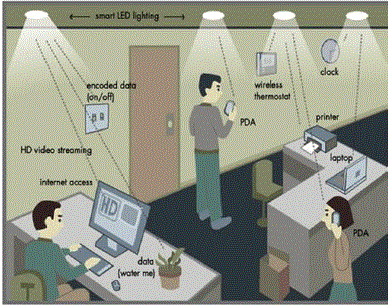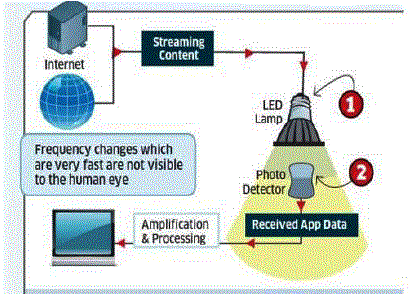Keywords
|
| VLC, LED, Wi-Fi, RF |
INTRODUCTION
|
| Li-Fi is a new paradigm for optical wireless technology to provide unprecedented connectivity within a localized datacentric environment. The increasing demand for higher bandwidths, faster and more secure data transmission as well as environmental and undoubtedly human friendly technology heralds the start of a major shift in wireless technology, a shift from RF to optical technologies.[1] |
| Li-Fi is a VLC technology. But VLC represents only a fraction of what appears to be a much larger movement towards optical wireless technologies in general. Li-Fi technology was developed by a team of scientists including Dr Gordon Povey, Prof. Harald Haas and Dr Mostafa Afgani at the University of Edinburgh. The term Li-Fi was coined by Prof. Haas when he amazed people by streaming high-definition video from a standard LED lamp, at TED Global Conference on 12th July 2011. [2] Li-Fi should not be confused with the more general term visible light communications (VLC), which is the use of the visible light portion of the electromagnetic spectrum to transmit information. |
| We all know about LED and of its very interesting property that its intensity can be modulated at very high speed, it can be switched ON-OFF at very high speed that even human eye can’t detect, this fundamental property is used in the Li-Fi technology. Just the same way as in the TV-remote there’s a single infrared LED which blinks when we press the button or transmit the data from remote to TV similarly in Li-Fi we replace single infrared LED by source with many LED’s in visible region and we exchange thousands of data streams parallel at more high speed. |
| Li-Fi would use transceiver-fitted LED lamps that can light a room as well as transmit and receive information. This technology uses a part of the electromagnetic spectrum that is still not greatly utilized- The Visible Spectrum. It is possible to encode data in the light by varying the rate at which the LEDs flicker on and off to give different strings of 1s and 0s. The LED intensity is modulated so rapidly that human eyes cannot notice, so the output appears constant. An example of Li-Fi environment is shown in Fig 1. |
| Li-Fi has the advantage of being able to be used in electromagnetic sensitive areas such as in aircraft, nuclear power plants, oil and gas installations and other places without causing interference. However, the light waves used cannot penetrate walls which makes Li-Fi significantly more secure relative to Wi-Fi.[3] |
| The Li-Fi Consortium has also been established to work on standardizing VLC communications, but the rapid evolution of the technology minimizes the impact of any standardization effort. Both the IEEE 802 workgroup and the Li-Fi Consortium fail to account for the emergence of optical orthogonal frequency-division multiplexing (O-OFDM) systems which provide significant benefits with regard to data rates, multiple-access and energy efficiency.[4] In fact, Dr Gordon Povey provides a top level overview of VLC development until the end of 2011. A number of companies offer uni-directional VLC products, however, the only known bi-directional system on offer is by pureVLC. PureVLC is an original equipment manufacturer (OEM) firm set up to commercialize Li-Fi, by bring out Li-Fi products for integration with existing LED-lighting systems.[5] |
WORKING TECHNOLOGY
|
| The functioning of Li-Fi technology is just simple. You will have a light source at one end like a LED and a photo detector on the other end. As soon as, LED starts glowing, photo detector on other end will detect light and get a binary 1 otherwise binary 0.[6] VLC is a data communication medium, which uses visible light between 400 THz (780 nm) and 800 THz (375 nm) as optical carrier for data transmission and illumination. It uses fast pulses of light to transmit information wirelessly. The main components of this communication system are 1) a high brightness white LED, which acts as a communication source and 2) a silicon photodiode which shows good response to visible wavelength region serving as the receiving element as shown in Fig 2. |
| Li-Fi is typically implemented using white LED light bulbs at the downlink transmitter. These devices are normally used for illumination only by applying a constant current. However, by fast and subtle variations of the current, the optical output can be made to vary at extremely high speeds. This very property of optical current is used in Li-Fi setup. The operational procedure is very simple: if the LED is on, you transmit a digital 1, if it’s off you transmit a 0. The LEDs can be switched on and off very quickly, which gives nice opportunities for transmitting data. So what you require at all are some LEDs and a controller that code data into those LEDs. We have to just vary the rate at which the LED’s flicker depending upon the data we want to encode. Further enhancements can be made in this method, like using an array of LEDs for parallel data transmission, or using mixtures of red, green and blue LEDs to alter the light’s frequency with each frequency encoding a different data channel. Such advancements promise a theoretical speed of 10 Gbps- meaning you can download a full high-definition film in just 30 seconds.[7] |
APPLICATIONS OF LI-FI
|
A. AIRPLANES
|
| Wi-Fi cannot be efficiently used in the airplanes. The RF waves can cause interference with the radio of the pilot. So to overcome this problem Li-Fi can be used. Also the passengers have to pay a huge amount of money for the "service" of dial-up speed Wi-Fi on the plane. Li-Fi could easily solve this problem. |
B. SMART MUSEUMS
|
| Another area where communications and radiation levels are intensely monitored, museums have strict rules about the environments where they store their treasures. Li-Fi could enable a museum to deliver much more information on prices in their collection than those tiny cards they paste to the walls could ever dream of. You could learn about the artist’s history, listen to an audio tour, peruse recent auctions of their work, and may be even stream. |
C. AVOIDING ACCIDENTS
|
| If you were texting to someone while driving, sensors implanted in your front and rear bumpers could receive data transmitted from the rear lights of that car that just veered into your lane. Both drivers are warned and the accident is averted. This can also work with traffic lights, possibly sending your car info about road accidents, warning you about that guy you can’t see speeding toward the intersection, or instantly transmitting his plate number to the cops when he does. |
D. YOU MIGHT JUST LIVE LONGER
|
| For a long time, medical technology has lagged behind the rest of the wireless world. Operating rooms do not allow Wi-Fi over radiation concerns, and there is also that whole lack of dedicated spectrum. While Wi-Fi is in place in many hospitals, interference from cell phones and computers can block signals from monitoring equipment. Li-Fi solves both problems: lights are not only allowed in operating rooms, but tend to be the most glaring (pun intended) fixtures in the room. And, as Haas mentions in his TED Talk, Li-Fi has 10,000 times the spectrum of Wi-Fi, so maybe we can, I dunno, delegate red light to priority medical data. Code Red![8] |
E. SMARTER POWER PLANTS
|
| Wi-Fi and many other radiation types are bad for sensitive areas. Like those surrounding power plants. But power plants need fast, inter-connected data systems to monitor things like demand, grid integrity and ( nuclear plants) core temperature. The savings from proper monitoring at a single power plant can add up to hundreds of thousands of dollars. Li-Fi could offer safe, abundant connectivity for all areas of these sensitive locations. Not only would this save money related to currently implemented solutions, but the draw on a power plant’s own reserves could be lessened if they haven’t yet converted to LED lighting. |
F. ON OCEAN BEDS
|
| This can even work underwater where Wi-Fi fails completely, thereby throwing open endless opportunities for military operations.[9] Underwater ROVs, operate from large cables that supply their power and allow them to receive signals from their pilots above. ROVs work great, except when the tether isn’t long enough to explore an area, or when it gets stuck on something. If their wires were cut and replaced with light — say from a submerged, high-powered lamp — then they would be much freer to explore. They could also use their headlamps to communicate with each other, processing data autonomously and referring findings periodically back to the surface, all the while obtaining their next batch of orders. |
G. IT COULD KEEP YOU INFORMED AND SAVE LIVES
|
| Say there is some natural calamity in some country. The average people may not know what the protocols are for those kinds of disasters. Until they pass under a street light, that is. Remember, with Li-Fi, if there’s light, you’re online. Subway stations and tunnels, common dead zones for most emergency communications, pose no obstruction. Plus, in times less stressing cities could opt to provide cheap high-speed Web access to every street corner. |
CONCLUSION
|
| The possibilities are numerous and can be explored further. If this technology can be put into practical use, every bulb can be used something like a Wi-Fi hotspot to transmit wireless data and we will proceed toward the cleaner, greener, safer and brighter future. The concept of Li-Fi is currently attracting a great deal of interest, not least because it may offer a genuine and very efficient alternative to radio-based wireless. As a growing number of people and their many devices access wireless internet, the airwaves are becoming increasingly clogged, making it more and more difficult to get a reliable, high-speed signal. This may solve issues such as the shortage of radio-frequency bandwidth and also allow internet where traditional radio based wireless isn’t allowed such as aircraft or hospitals. One of the shortcomings however is that it only work in direct line of sight. |
| Although this technology sounds like a replacement to Wi-Fi but this high speed data transferring technology also has some limitations that is the inability of light to pass through obstacles. It cannot pass through walls and can be blocked. If the light signal is blocked, we can seamlessly switch back over to radio waves (Wi-Fi). |
| Now when we have to transmit data we got both light and radio waves to use accordingly as per the environment around us. The conclusion is that there is no dead end when it comes to technology, science always shows the path. |
| |
Figures at a glance
|
 |
 |
| Figure 1 |
Figure 2 |
|
| |
References
|
- www.lificonsortium.org/
- Harald Haas, “Wireless data from every light bulb”, TED Global, Edinburgh, July 2011.
- Ian Lim, “Li-Fi – Internet at the Speed of Light”, the gadgeteer, 29 August 2011.
- Tsonev, D., Sinanovic, S., Haas, H., “Complete Modeling of Nonlinear Distortion in OFDM-Based Optical Wireless Communication”, IEEE Journal of Lightwave Technology, Volume:31, Issue:18, 3064 – 3076, 2013
- “Visible-light communication: Tripping the light fantastic: A fast and cheap optical version of Wi-Fi is coming”, Economist, dated 28 Jan 2012
- http://newtecharticles.com/new-li-fi-technology-to-access-internet/
- http://en.wikipedia.org/wiki/Li-Fi
- http://www.dvice.com/archives/2012/08/lifi_ten_ways_i.php
- http://www.slideshare.net/accessallow/lifi-technology
|